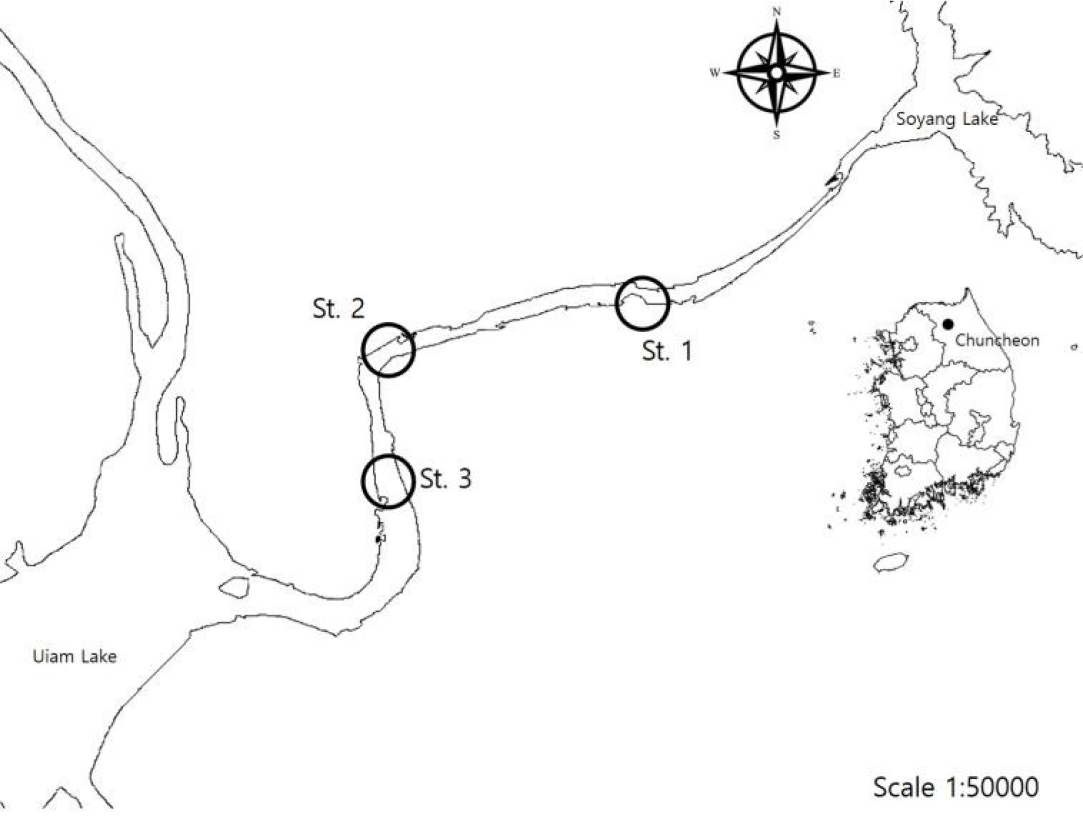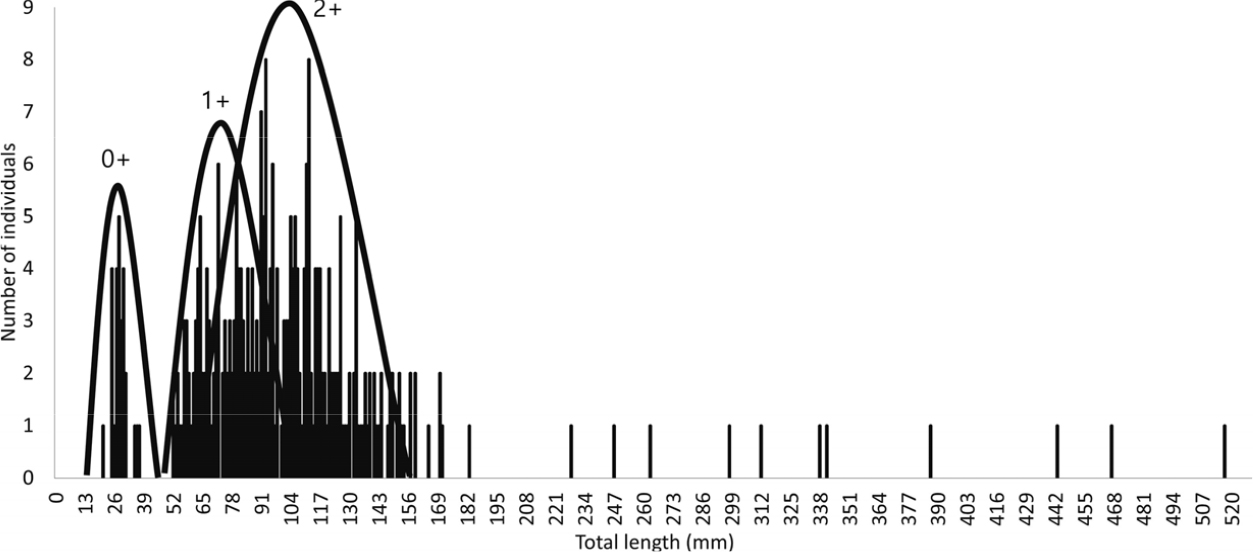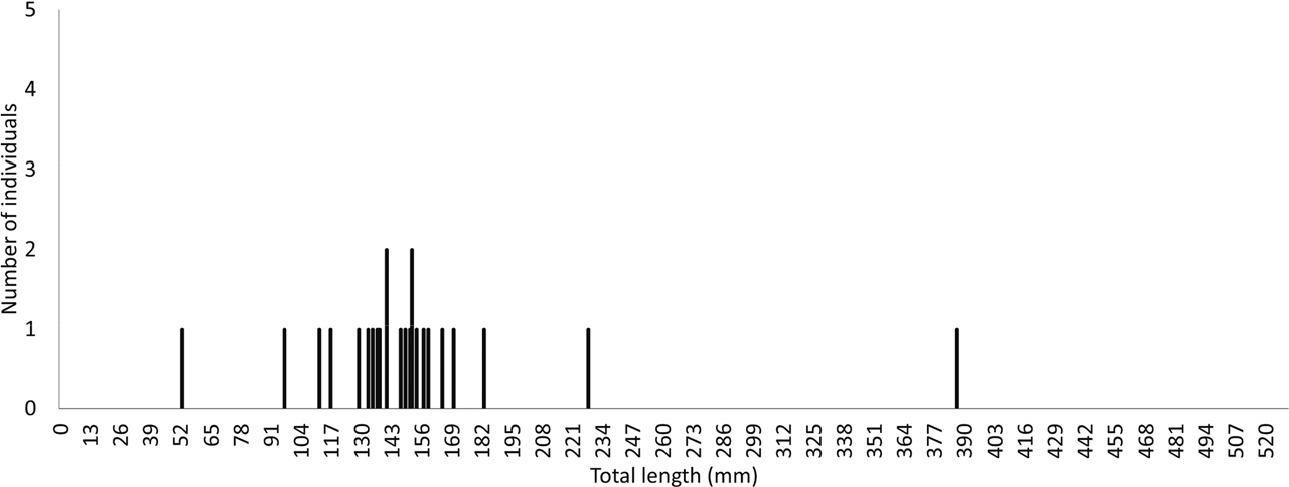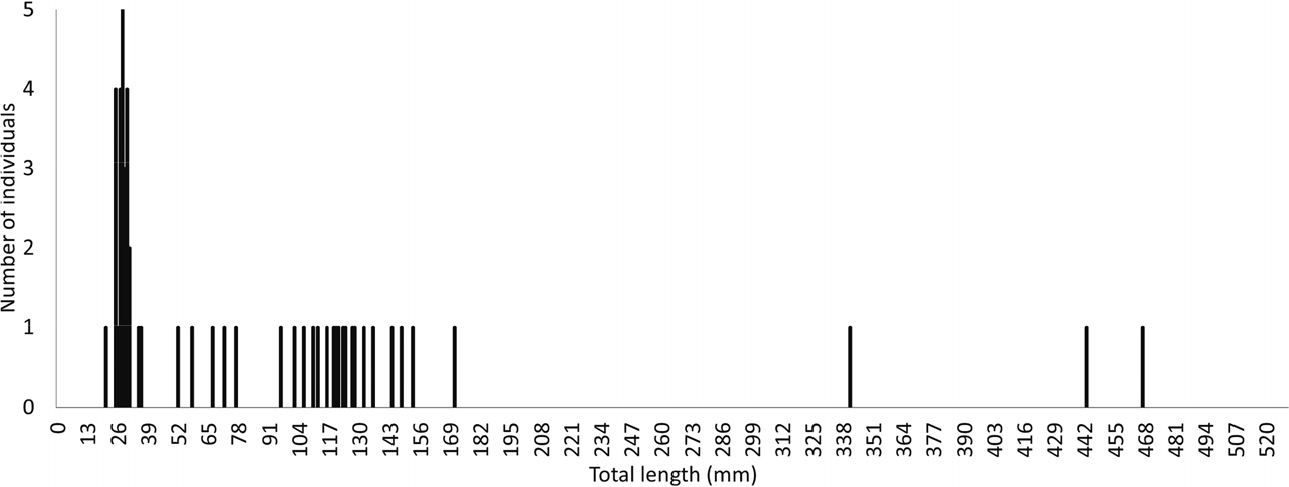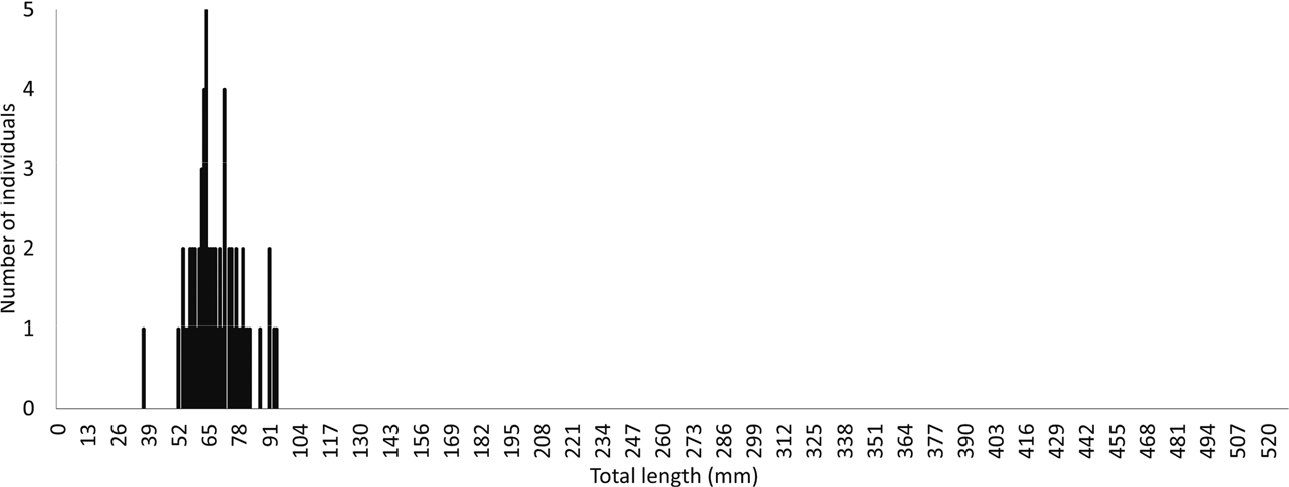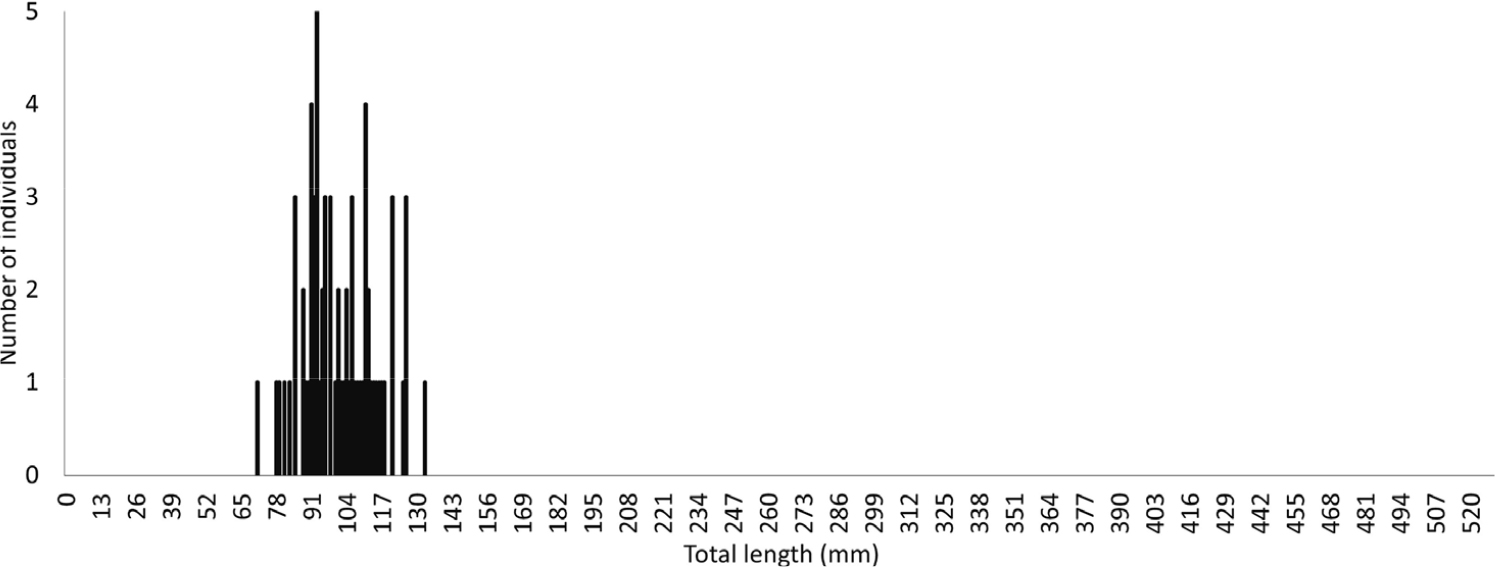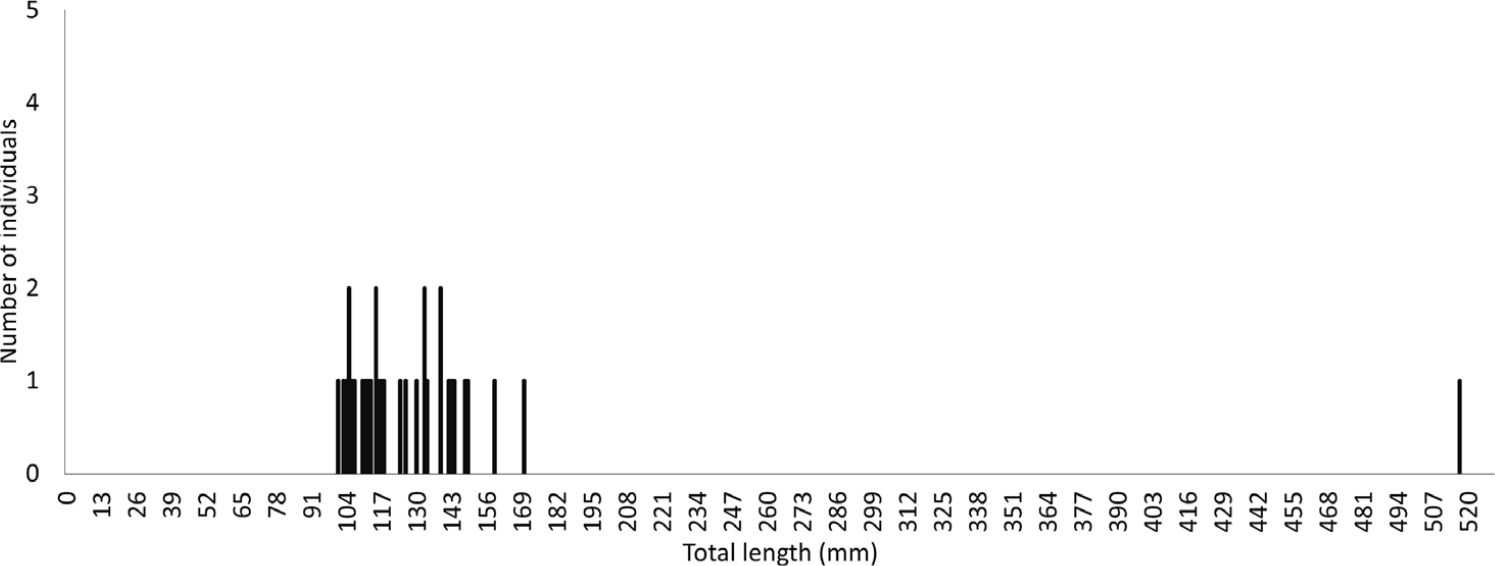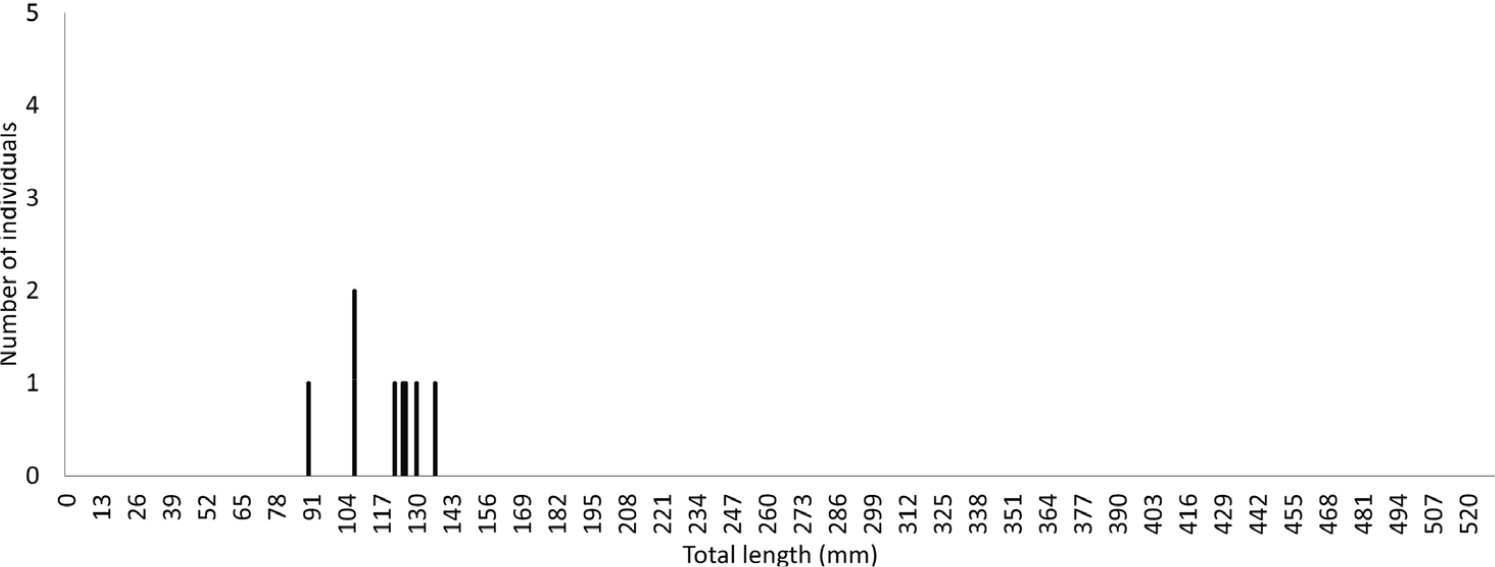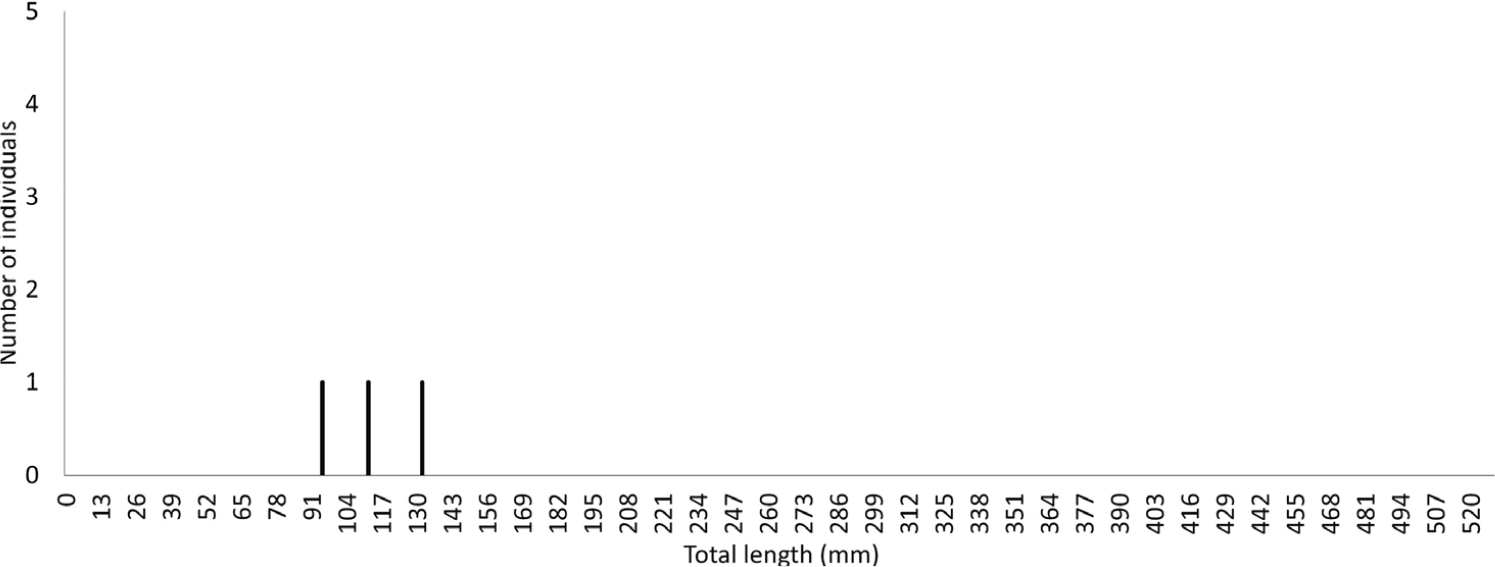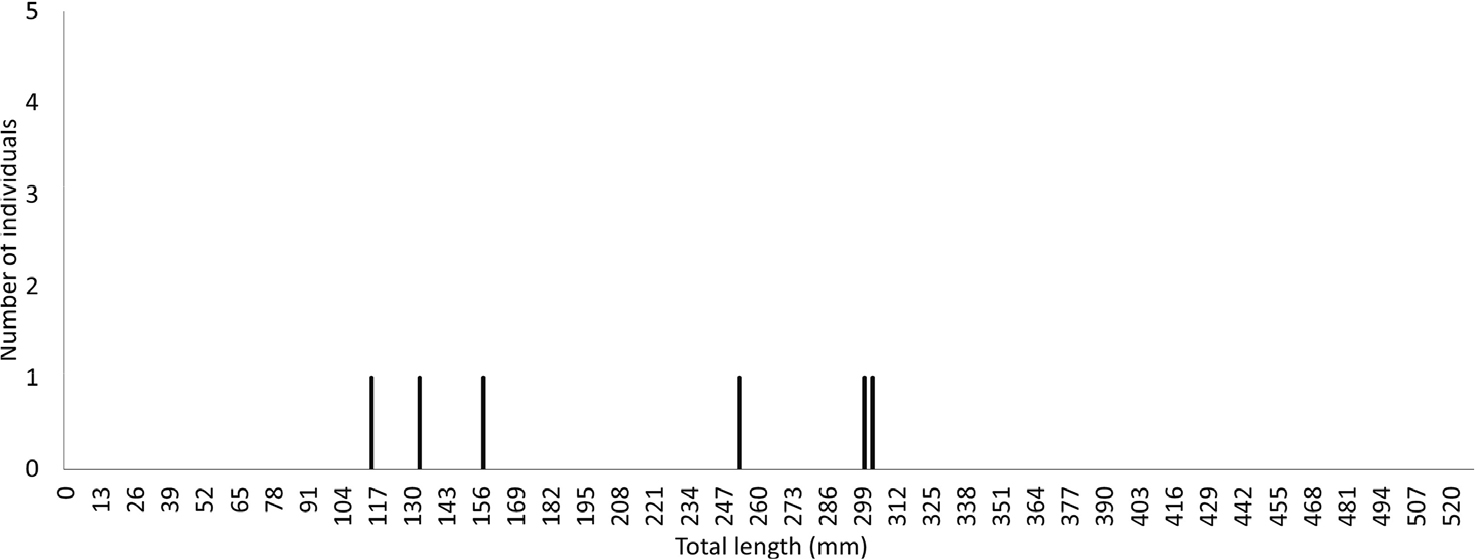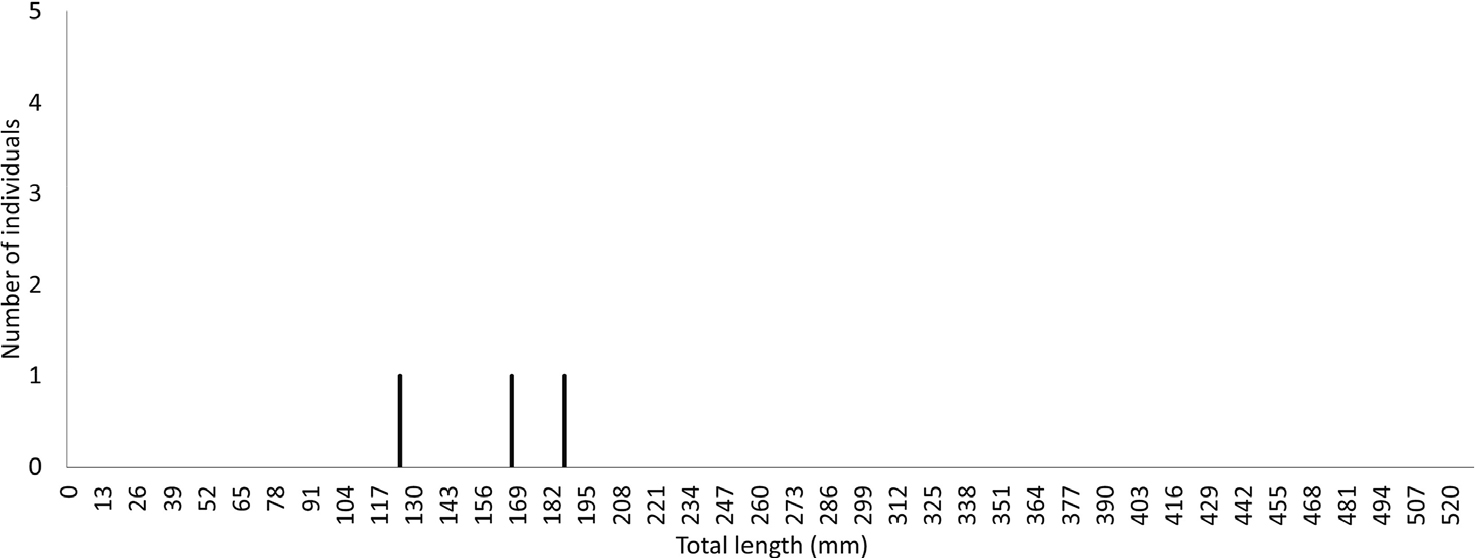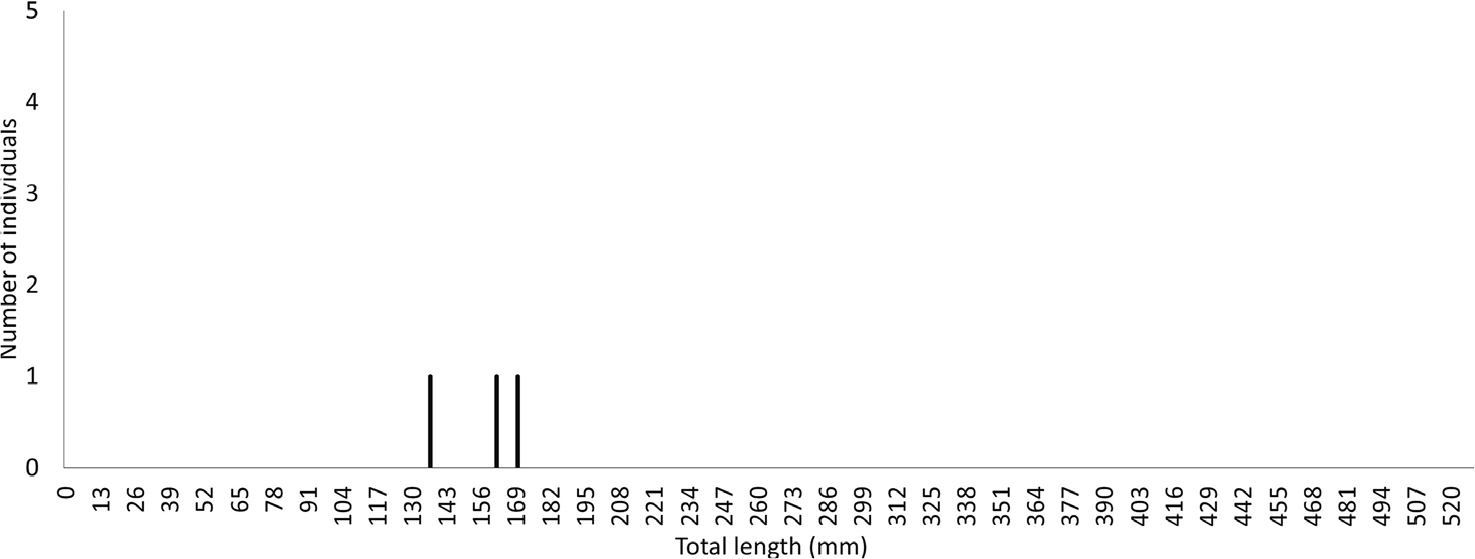서 론
보편적으로 하나의 종은 하나의 지역생태계에 적응하고 진화하며, 서식지 확장이 점진적으로 이루어진다(Park et al., 1998). 19세기 이후 국가 간 교류가 증가하면서 합법적 또는 비합법적으로 대륙을 넘나드는 종의 이동이 발생하였으며 이로 인해 외래종의 개념이 본격적으로 대두되었다(ME, 2006). 특히 외래종 중 일부가 토착 생태계에 심각한 교란을 일으키면서 외래종에 대한 문제의식은 전 세계적으로 퍼져나가 다방면에서의 연구를 촉진했다(Park et al., 1998).
브라운송어(Salmo trutta)는 연어목(Salmoniformes) 연어과(Salmonidae)에 속하는 어종으로, 최대 1 m까지 성장할 수 있는 대형 육식성 어종이다(생태계교란생물 현장관리 안내서-국립생태원). 브라운송어(S. trutta)의 본래 서식지는 유럽, 북아프리카, 서아시아 지역이나, 현재 전 세계적으로 확산되고 있으며, 세계자연보전연맹(IUCN)에서는 브라운송어(S. trutta)를 ‘세계 최악의 100대 외래 침입종’으로 지정하였다(Lowe et al., 2000; NIE, 2023). 경쟁관계나 천적이 없는 환경에 도입된 육식성 외래종은 고립된 포식자로서 무분별하게 먹이 활동을 하게 된다(Azuma, 1992; Lee, 2018). 브라운송어(S. trutta)는 저서생물부터 육상곤충, 어류까지 광범위한 먹이선택 특성을 가지고 있는데 특히 Atkinson and Gray(2002)는 도입된 일부 지역에서 특정 종을 지역절멸 시키거나, 생태계 순환을 파괴하여 조류의 증가를 야기했다고 보고하였다. 그러므로 환경부는 브라운송어(S. trutta)의 위해성을 우려해 우리나라의 생태계교란생물로 지정하였으며 유입경로를 추적하는 등의 다양한 연구를 수행하려고 하고 있다(Park et al., 2022).
국내 브라운송어(S. trutta)의 서식지로 알려진 소양강은 강원도 인제군과 춘천시를 지나는 강으로, 홍천군 내면 명개리 만월봉 남쪽 계곡에서 발원하여 북서쪽으로 흐르는 하천이다. 소양강 상류에는 사력댐인 소양강댐(총 저수량 29억 톤)이 위치하고 있으며 소양강댐에서 방류하는 차가운 저층의 물로 인해 소양댐 하류지역의 수온은 연중 17°C 이하로 낮게 유지된다(NIER, 2023; Yi et al., 2006). 하류지점인 의암호와의 합류점까지 약 10 km 구간이 이 냉수의 영향을 받고 있으며 이러한 수온 특성과 댐 하류라는 지리적 특성에 의해 유입하천인 율문천과의 합류점 부근을 제외하고는 어류상이 매우 빈약하여 브라운송어(S. trutta)에 의한 생태계 교란이 더욱 심각할 것으로 예상된다.
어류 생물학적으로 성장도 및 비만도는 어류의 생태, 번식, 역사 및 생애를 예측하는데 도움이 되며, 서식지에서의 어류를 관리, 보전하는 데 중요한 역할을 한다(Arslan et al., 2004; Rawat et al., 2014). 실제로 Choi et al.(2006)은 성장도와 비만도가 어류의 건강성과 개체군의 순간성장속도를 나타내는 지수로서, 개체군의 평가와 서식지의 수환경 평가 시 활용할 수 있는 지표라고 보고하였다.
외국에서는 성장률 뿐만 아니라, 배아 성장과 발달, 계절별 이동, 미소서식지 선택, 식성, 계통지리학, 수온 영향, 스트레스로 인한 코티솔 변화, 소하성/담수성 브라운송어(S. trutta)의 생활사, 개체군 유전학 등 광범위한 연구가 이루어졌으나(Ball, 1961; Hari et al., 2006; Jenkins et al., 1999; Meyers et al., 1992; Ojanguren and Brana, 2003; Saint-Pé et al., 2019; Sanz, 2017; Shirvell and Dungey, 1983; Sloman et al., 2001), 국내에는 기본적인 생태를 밝히는 Park et al.(2022)의 연구 1건만이 진행되었다.
따라서 본 연구에서는 소양강 일대에 서식하는 브라운송어(S. trutta)의 전장과 체중을 이용한 연령분포, 성장도 및 비만도 파악 등을 통해 소양강에서 브라운송어(S. trutta)의 정착 양상을 확인하는 것에 의의를 두며, 앞으로의 많은 연구에 도움이 되고자 한다.
재료 및 방법
조사시기 및 지점
조사는 2022년 5월부터 2023년 5월까지 매월 1회씩 실시하였으며, 소양댐의 방류로 접근이 불가한 7, 8월은 조사를 실시하지 못하였다(Table 1). 조사지점은 소양강 본류 서식지가 다양하고 지류의 영향이 적은 3개 지점을 선정하여 조사하였다(Fig. 1, Table 2).
Table 1.
Period of study
| Order | Year | Period | Note |
| 1st | 2022 | 5.30 | |
| 2nd | 6.28 | ||
| 3re | 9.24 | Unable to study due to dam discharge in July, August | |
| 4th | 10.20 | ||
| 5th | 11.11 | ||
| 6th | 12.08 | ||
| 7th | 2023 | 01.29 | |
| 8th | 02.12 | ||
| 9th | 03.06 | ||
| 10th | 04.14 | ||
| 11th | 05.11 |
Table 2.
Coordinates of each station in the study area
| Station | Coordinates | |
| latitude | longitude | |
| St. 1 | 37°92’64.96” | 127°77’92.69” |
| St. 2 | 37°92’22.61” | 127°74’69.34” |
| St. 3 | 37°90’64.84” | 127°74’53.57” |
채집 및 동정
브라운송어(S. trutta)의 채집은 지점 1과 2에서는 족대(망목 5 × 5 mm) 및 투망(망목 7 × 7 mm)을 사용하였으며, 지점 3에서는 정치망(망목 5 × 5 mm)과 자망(망목 40 × 40 mm)를 각각 2-4일, 12시간 설치 후 어류를 수거하였다. 채집된 브라운송어(S. trutta)는 10% 포르말린으로 고정 후 실험실로 운반하여 실험하였다.
성장도 비만도 분석
본 조사에서 출현하는 브라운송어(S. trutta)는 Length-Weight Relationship(성장도)과 Condition Factor(비만도)를 구하였으며, 그 식은 다음과 같다(Anderson and Neumann, 1996; Pauly, 1984).
성장도
W = aLb
W = total weight, L = total length
a와 b = parameters
비만도
K = W/L3 × 105
K = condition factor
W = total weight, L = total length
결 과
전장분포 및 연령구조
채집된 브라운송어(S. trutta)의 월별, 전체 전장분포를 통해 연령구조를 분석한 결과 10-50 mm가 당년생, 40-90 mm가 만 1년생, 70-160 mm가 만 2년생으로 보이며, 가장 큰 개체인 517 mm 개체는 만 4년생 이상일 것으로 추정된다(Fig. 2). 한 개체만 채집된 경우를 제외한 월별 전장의 평균은 2022년 5월에는 146.5 mm, 6월에는 28 mm, 9월에는 67.2 mm, 10월에는 89.3 mm, 11월에는 101 mm, 12월에는 123 mm, 2023년 1월에는 107 mm로 점진적으로 성장하고 있는 것으로 나타났다. 특히 6월 평균 전장 28 mm의 작은 개체들은 대부분이 지점 1에서 채집된 개체들이다. 그리고 9월과 10월에도 지점 1에서 주로 출현하였다. 2023년 2월부터 5월까지는 같은 크기의 개체들이 2개체 이상 채집되지 않았다(Fig. 3, 4, 5, 6, 7, 8, 9, 10, 11, 12, 13). 6월에 당년생 치어가 다량 채집된 것으로 보아 겨울과 이른 봄이 산란기로 추정된다.
성장도 및 비만도 분석
채집된 브라운송어(S. trutta)의 각 월별, 전체 성장도와 비만도를 분석한 결과는 다음과 같다(Fig. 14, 15, 16, 17, 18, 19, 20, 21, 22, 23, 24, 25, Table 3). 전체 성장도는 3.03, 비만도는 양(+)의 값을 보여 양호한 성장을 이루고 있다고 파단된다. 각 월별로 살펴보면 2022년 5월에는 성장도 3.01 비만도 (-), 6월에는 성장도 3.15 비만도 (+) 9월에는 성장도 2.86, 비만도 (-), 10월에는 성장도 2.98, 비만도 (-), 11월에는 성장도 3.10, 비만도(+), 12월에는 성장도 3.04, 비만도 (+), 2023년 1월에는 성장도 3.10, 비만도 (+), 2월에는 성장도 3.21, 비만도(+), 3월에는 성장도 2.93, 비만도 (-), 4월에는 성장도 3.17, 비만도 (+), 5월에는 성장도 3.24, 비만도 (+)로 나타나 2022년 5월, 9월, 10월, 2023년 3월을 제외하고는 성장이 양호한 것으로 나타났다.
Table 3.
Comparison of length-weight relationship and condition factor analysis of Salmo trutta in Soyang River
고 찰
성장도와 비만도는 어류 생물학적인 중요한 요소로(Sparre et al., 1989), 어류성장에 영향을 주는 먹이공급, 서식환경, 계절 등 다양한 요인의 대한 연구나 종 간 혹은 개체간의 건강성을 비교하는 등 다양한 목적으로 널리 사용된다(Bolger and Connolly, 1989).
본 연구는 생태계교란어종으로 지정된 브라운송어(S. trutta)의 정착에 따른 성장상태와 영양상태를 확인하기 위하여 국내 서식지로 알려진 소양강을 중심으로 조사를 수행하였으며, 총 348개체가 채집되었다.
전장분포도를 확인한 결과 10-50 mm가 당년생, 40-90 mm가 만 1년생, 70-160 mm가 만 2년생으로 나타났으며 대부분의 160 mm이하의 미성어개체로 채집되었다. 이는 터키(Yildirim and Arslan, 2007)와 노르웨이(Jonsson et al., 1999)의 경우도 마찬가지로 만 2년생에서 3년생 이하의 개체가 대부분 채집되었다. 다른 지역의 연령군의 평균 전장을 살펴보면 터키(Yildirim and Arslan, 2007)에서 당년생 68 mm, 만 1년생 92 mm, 만 2년생 125 mm로, 노르웨이(Jonsson et al., 1999)에서 당년생 29-43 mm, 만 1년생 55-91 mm, 만 2년생 90-138 mm 로 본 연구의 평균전장과 매우 흡사했으나, 티벳(HAO et al., 2007)과 펜실베니아(Kemp and Spotila, 1997)의 전장은 티벳 만 1년생 100-123 mm 만 2년생 93-274 mm, 펜실베니아 만 1년생 15-113 mm, 만 2년생 113-247 mm 로 본연구보다 크게 나타났다. 이는 티벳과 펜실베니아 하천의 하천 차수가 본 연구지보다 높으며, 연평균 기온이 낮아 낮은 수온을 유지하여 브라운송어(S. trutta)의 성장에 더 좋은 서식환경을 제공하였을 것으로 보인다(Lotrich, 1973). 한편 치어나 미성어 대부분이 지점 1에서 재집되었으며 이는 소양6교와 7교 사이가 주로 산란지나 치어 및 미성어 생육장으로 활용되고 있음을 보여주는 결과라 판단된다. 특히 정치망(지점 3)과 플라이 낚시 등으로 확인된 결과에 의하면 우두교와 소양 6교 사이에는 성어와 미성어가 분포하는 것으로 보인다. 그리고 기타 의암호 조사에서 40-65 cm 크기의 개체들이 발견되는 것은 의암호가 성체들의 서식처로 활용되고 있음을 보여준다.
전체 성장도와 비만도를 살펴보면 성장도 3.03, 비만도 포지티브(+)로 본 소양강에서 비교적 안정적인 개체군을 유지하고 있는 것으로 나타났다. 그러나 일부 시기의(10월, 11월, 4월) 성장도는 3.00 이하, 비만도는 네거티브(-)값을 보여 성장이 더딘 것으로 나타났다. 특히 4월의 경우 채집된 개체수가 적어(3개체) 성장도와 비만도가 낮게 나타난 것으로 판단된다. 다른 조건 및 국가의 브라운송어(S. trutta) 성장도와 비만도를 비교해보면 우선 성장도는 실험실(Savić et al., 2019)에서 권장량의 사료를 급이한 결과, 3.36로 매우 높아 브라운 송어의 성장 잠재력은 매우 큰 것으로 나타나, 양식환경에 잘 적응할 것으로 보여졌다. 반면, 터키(Arslan et al., 2004)와 유타(Sigler, 1952)에서는 모두 2.96으로 성장도가 낮은 것으로 나타났다. 계절별로 확인한 결과 본 연구에서는 가을을 제외하고 모두 3.00 이상으로 나타났다. 터키(Arslan et al., 2004)의 경우 가을과 겨울에서 3.00 미만으로 성장이 더딘 것으로 나타났으나, 인도(Rawat er al.,, 2014)의 경우 1년간 모든 기간에서 3.00 이상의 값으로 성장이 매우 양호한 것을 확인할 수 있었다. Arslan et al.(2004)의 연구와 본 연구에서 가을 또는 겨울 가을에 성장도 값이 낮은 것은 기온이 하강함에 따라 먹이원이 감소한 것, 그리고 산란 후 성체들의 체중이 급격히 감소한 영향으로 보여진다. 또한, Choi et al.(2006)의 연구에서 겨울철에는 어류의 활동성이 떨어지면서 먹이활동 또한 감소하여 공복률이 늘어난다고 보고했으며, 본 연구도 이러한 영향이 있을 것으로 판단된다.
비만도의 기울기는 개체들의 먹이 활동성 또는 먹이의 영향력을 보여주는 결과이며, 다른 지역과의 비교는 개체군의 서식환경을 평가하는데 도움이 된다.
소양강에서의 비만도는 미국(Pender and Kwak, 2002; 0.99-1.16) 및 스웨덴(Johnsson and Bohlin, 2005; 0.98-1.09)과는 큰 차이가 보이지 않았으나, 인도(Rawat et al., 2014; 1.43-2.16)와 터키(Alp et al., 2005, 1.40-1.60), 우크라이나(Barylo et al., 2021; 1.24-1.28), 스페인(Sánchez-Hernández, 2011; 1.23-1.29)에 비해서는 낮게 나타났다. 이러한 원인은 하천차수의 차이로 보이며, 차수가 커질수록 먹이원이 증가, 다양화 되면서 영양상태가 매우 좋게 나타난 것으로 해석된다(Hur et al., 2009). 댐에서의 방류는 발전, 집중강우 등 인간의 편의에 따라 방류량이 결정되기 때문에 유량의 변화가 급격하고 강하게 일어나 하류 하천의 물리적 안정성을 떨어뜨린다(Ryu, 1996). 소양댐도 마찬가지로 발전을 위해 주기적으로 다량의 물을 방류하며 여름철 장마기에는 수문을 열어 최대 600 m3/S의 물을 방류한다(Kim et al., 2002; ME, 2023). 이로 인해 먹이활동이 특정 시간대로 제한되며, 먹이원의 공급 또한 불안정해 자연하천인 타 지역에 비해 비만도 값이 낮게 나타난 것으로 보여진다. 또한 소양호 낮은 수온의 영향으로 브라운송어(S. trutta)의 분포 구역도 의암호로 확대된 것으로 보인다.
요 약
본 연구는 2022년 생태계교란어종으로 지정된 브라운송어(Salmo trutta)의 서식 및 정착 양상을 확인하기 위하여 브라운송어(Salmo trutta)의 국내 서식지로 알려진 강원도 춘천시에 위치한 소양강 일대를 2022년 5월부터 2023년 5월까지 매월 1회씩 조사하여 총 348개체를 포획하였다. 연령구조를 분석한 결과 10-50 mm가 당년생, 40-90 mm가 만 1년생, 70-160 mm가 만 2년생으로 나타났으며 성장도는 2022년 10월, 11월, 2023년 4월에 3.00을 넘지 못하였으며, 비만도는 2022년 6월, 10월, 11월, 2022년 4월에 네거티브(-)로 일시적으로 성장이 양호하지 않은 것으로 나타났다. 그러나 전체기간으로 살펴보면 성장도는 3.03, 비만도는 포지티브(+)로 성장이 양호한 것으로 나타났다. 따라서 브라운송어(Salmo trutta)는 우리나라 소양강에 비교적 잘 정착하고 개체군이 안정화 된 것으로 보인다.



